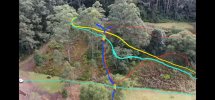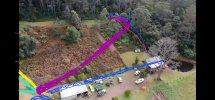@Lagwagon
how I see that picture, every bit you move the end point to the right it involves a bigger grade change. Let's see if Guy comes back and confirms, but it looks like the bottom of the slope, slopes to the right too. I get that from the pond placement.
That might be why he chooses that end?
EDIT: Guy if I were free to travel I'd come give you a hand. That looks like beautiful country.
Where abouts are you mate? We're just 1hr nth of Syd.
In the 2 years its been since I started this thread (2 years!) I have got a lot more experience working on the property (had a LOT of other jobs take priority...) which is nice to now know. But that said I still want to go carefully up this job - especialaly building it appropriately for longevity in the face of peak rainfall events...!
I have some updated drone vision Ive linked here:
And while i'm at it ill re-upload a few screenshots of it overlayed with some drawings showing what updated route info i've been piecing together in my head...
Colour legend:
Dark Blue - Natural Water flow (Main causeway/dam overflow that runs behind cottage is only 'proposed' at this stage... No idea if it's viable yet... Thoughts?)
Aqua - T1 & L1 ( "Top Route" 1 & "Lower Route" 1 are most likely what I'm currently planning to cut...)
Yellow - T2 'Alternate Top route' (Is this straight even possible over the 133m in length? Height to traverse is 20m, with that steep hump in the middle to add to complexity)
Red - Defines in and/or along it's borders steep area/s of hillside (40-50 degrees)
Orange - Current Bridge, and two proposed pipes
Purple - T3 'Alternate Top Route' (Would require sculpting out a hair-pin turn right after the bridge, This possible route would have to end turning around and following up the ridge that meets the gully behind the cottage.
On all 3 possible "Top Routes" I imagine I'll have to incorporate some sort of 'sump' that takes the water flow volume and each of their respective velocities off it's drainage trench via pipes and then have to empty (with enough smart design that's appropriate) into the main causeway...
It's these drainage elements that I obviusly need to pay very sharp attention to design wise... The other pipes that would cross T1 and L1 routes further along their hillside I imagine are relatively easy to put in. I've done a few of those already using bushrock for headwalls and outflows. Looks great too!
cheers again to you all
@Lagwagon @R.D.G013 @ianjoub @Tones @Welder Dave @Stephen Doyle and anyone else for sharing your experince and feedback!
Hope this thread can help other newbies too.
Guy






